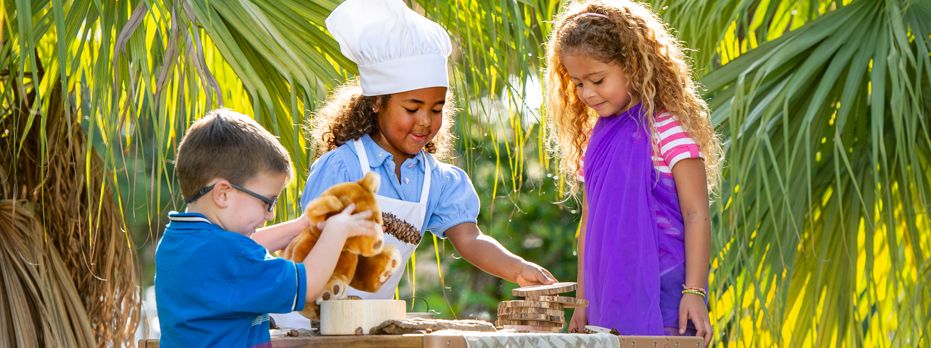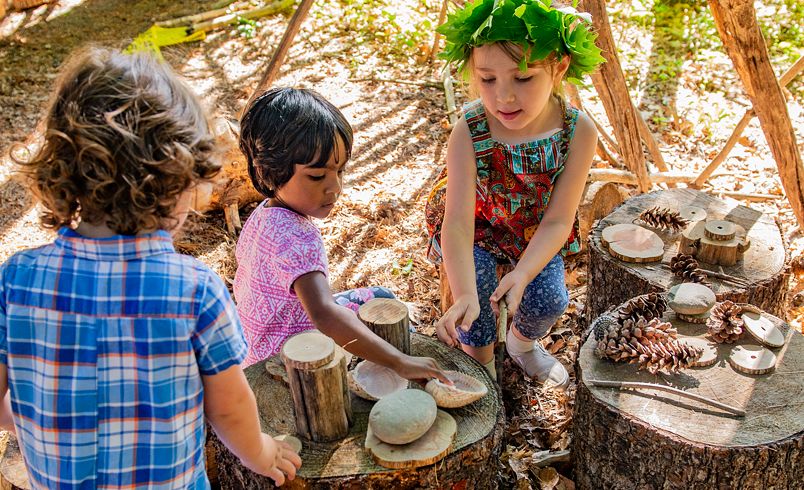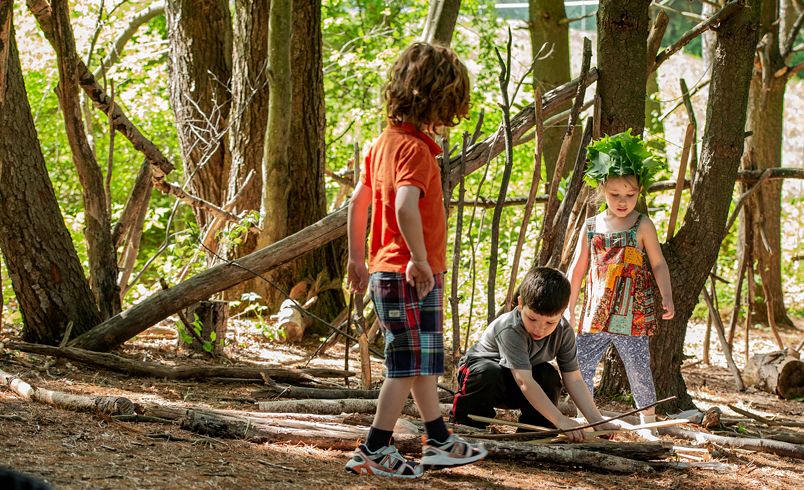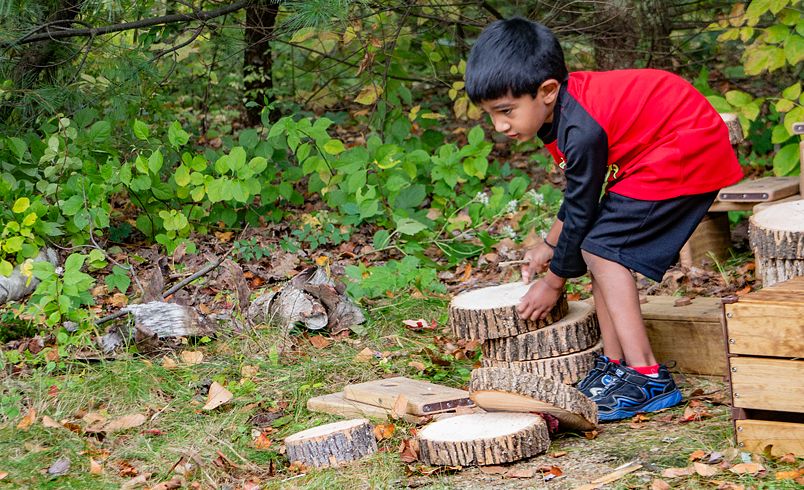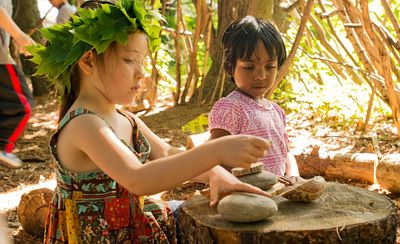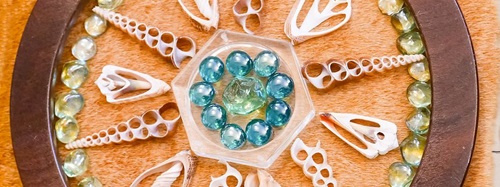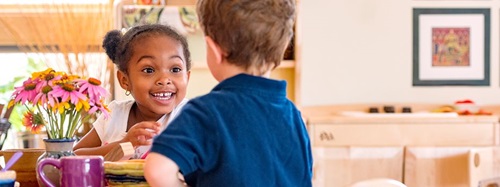Let's Play Outside:
The Importance of Pretend Play in Natural Settings
| June 2019“Come sit with me and wait for the squirrels! Let’s make a song to call them.”
“First we need to get more acorns. They won’t want to come to our house if we don’t have dinner ready for them.”
“You’re right. Let’s fill the whole bag up, then we can cook and wait for them at the tree in our house.”
These are the sounds of children at work and at play. Collaboration, creativity, imagination, inventiveness, problem-solving, coordination, physical strength—when children are given the space and time to freely play outdoors, truly the whole child is able to grow.
Even outside of the school setting, open, natural outdoor space is a treasured and limited commodity, especially in urban areas. Of course, there is a range of environments that can be referred to as “natural,” from untamed forests and grasslands to nature preserves to designed and constructed public parks. Many children only have access to more structured outdoor areas, such as playgrounds, ball courts, and running tracks, which are less flexible spaces for imaginative play.
Studies have shown play is crucial for many areas of children’s development—from physical strength to cognitive and linguistic growth. One 2008 study found that play contributes greatly to physical health—using more calories than comparable organized physical activities (Mackett & Paskins, 2008).
There is a growing amount of research showing that children who participate in complex, collaborative, pretend play are better able to regulate their emotions and implement creative problem-solving (Hoffman & Russ, 2012). High-level, complex pretend play can significantly facilitate children’s capacities for perspective taking, which can facilitate abstract thought (Bergen, 2002). According to a study done in early 2016, the more complex and detailed a young child’s pretend play is, the more advanced their cognitive processing needs to be—as their play stretches and grows, so do their brains (Li, Hestenes & Wang, 2016). The same goes for social skills—when preschool-aged children participate in pretend play that requires more complicated interactions with their peers (cooperation, collaboration, sharing, negotiating) they are practicing and strengthening their abilities to connect to other people in healthy, productive ways.
Setting the Stage for Play
Just as we deeply consider what materials we make available to our children in the classroom (open-ended, inclusive, differentiated), we ought to also be thoughtful about the space and supplies we provide for our students in their outdoor play and learning experiences. When looking at what children play with outside, think about the materials in natural settings: pine cones, sticks, leaves, trees, and rocks—as opposed to more fixed materials like slides, chin-up bars, and swings. These objects, like open-ended materials in the classroom (fabric scraps, blank paper, blocks) have more affordance. Affordance refers to the different functions each material can serve, or, afford (Fjørtoft, 2001).
For example, a stick can have a large affordance, and be used in pretend play as a wand, a ladle, or a cane. It can also be used in more game-based play as a baseball bat, or an obstacle in a course. When allowed more flexibility with materials in spaces with more affordance (i.e in natural outdoor spaces), children tend to engage in more complex pretend play. It is worth considering that the play that occurs in greener, more “natural” spaces can be different, and possibly more complex and developmentally beneficial for young children. When natural, outdoor play areas are not available to you and your students, consider bringing some open-ended, natural materials to the children in the space you do have (fabric scraps, rocks, seashells, ribbon, leaves, tote bags). You will be amazed by how different their play can become with these organic and/or undefined props.
According to the philosophy of Reggio Emilia, the learning environment is the “third teacher” in early childhood education, after the two classroom teachers (Edwards, Gandini & Forman, 1998). This environment should include not only the indoor early childhood classroom, but also the outdoor environment. The environments where children play have an effect on them and the quality of their play.
A study of a Forest School, a school facilitated completely outdoors in England’s Mersey Forest, found that it helped children connect with and learn not only about their natural environment, but also grow in “social skill development, confidence when interacting with the natural world, understanding, interest, motor skills, and leadership skills,” (Ridger, Knowles & Sayers, 2012).
Having taught for many years at an urban preschool with very close access to nature (Prospect Park in Brooklyn), I was able to see firsthand the social-emotional, physical, and cognitive benefits of unstructured play in a natural setting for the children I worked with. When taken to the more open, natural setting in the park, the children’s pretend play was dramatically more complex and sustained than when they were taken to the nearby playground. Children’s conversations were richer, the groups of children playing together were larger, play scenarios were more sophisticated and were sustained over multiple days. The children collaborated, negotiated, and created complex scenarios and characters together.
In New York City, many early childhood centers rely on contained yards or nearby constructed playgrounds for outdoor physical activity, if they are provided the regular opportunity to be outdoors at all. Very few NY public school students have access to actual natural settings (i.e., uncontained spaces with trees, grass, or wildlife). In some schools, children may go days or weeks without spending any time outdoors at all, much less within natural elements. Disparate access to nature while in school is just another example of broader inequalities in our education system and our society at large. However, with the right resources, all children in urban areas can have opportunities to interact with nature (taking field trips to forest preserves, large parks, or similar sites)—investments that will shape the future of our city and the promise of its youngest citizens.
Pretend play is a sacred part of childhood. Furthermore, it has been proven to aid in children’s development in many areas. Outdoor play, a scarce opportunity for many children living in urban areas, can provide even more benefits for children’s development—physically, socially, and emotionally. With all that hangs in tenuous balance in our country, we as educators, caregivers, and parents must be even more vigilant about every child’s human right to play in the great outdoors.
References
Bergen, D. (2002). “The role of pretend play in children’s cognitive development.” Early Childhood Research & Practice, 4(1). Retrieved: http://files.eric.ed.gov.ez-proxy.brooklyn.cuny.edu:2048/fulltext/ED464763.pdf
Edwards, C., Gandini, L., Forman, G. (1998). The hundred languages of children. Westport, CT: Ablex Publishing.
Fjørtoft, I. (2001). “The natural environment as a playground for children: The impact of outdoor play activities in pre-primary school children.” Early Childhood Education Journal, 29(2) 111–117.
Hoffman, J., Russ, S. (2012). “Pretend play, creativity, and emotion regulation in children.” Psychology of Aesthetics, Creativity, and the Art, 6(2) 175–184.
Li, J., Hestenes L.L., Wang, Y.C. (2016). “Links between preschool children’s social skills and observed pretend play in outdoor childcare environments.” Early Childhood Education Journal, 44, 61–68.
Mackett, R.L., Paskins, J. (2008). “Children’s physical activity: The contribution of playing and walking.” Children and Society, 22, 345–357.
Ridgers, N.D., Knowles, Z.R., Sayers, J. (2012). “Encouraging play in the natural environment: A child-focused case study of Forest School.” Children’s Geographies, 10 (1) 49–65.
Copyright © Exchange Press. Reprinted with permission from Exchange magazine. All rights reserved. Visit us at www.ChildCareExchange.com or call (800) 221-2864.

